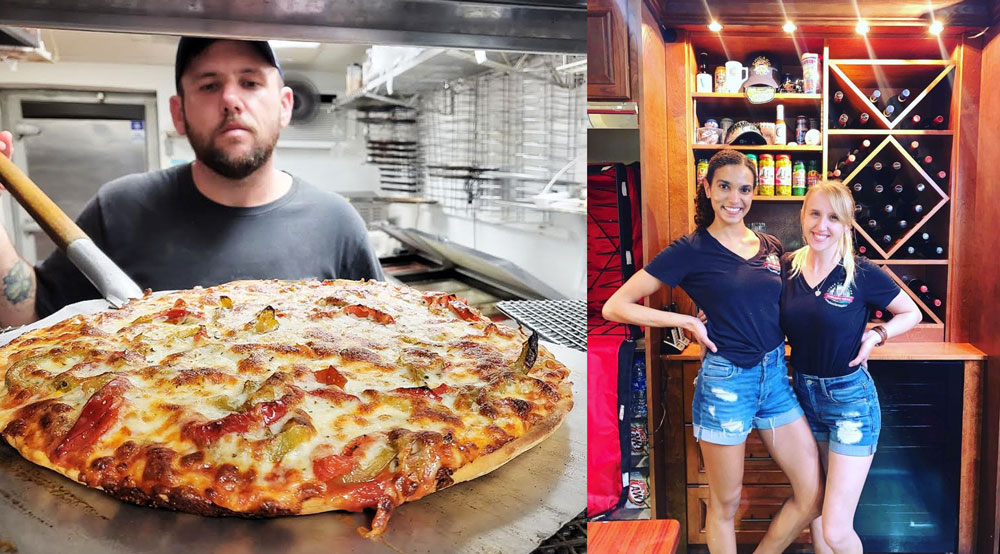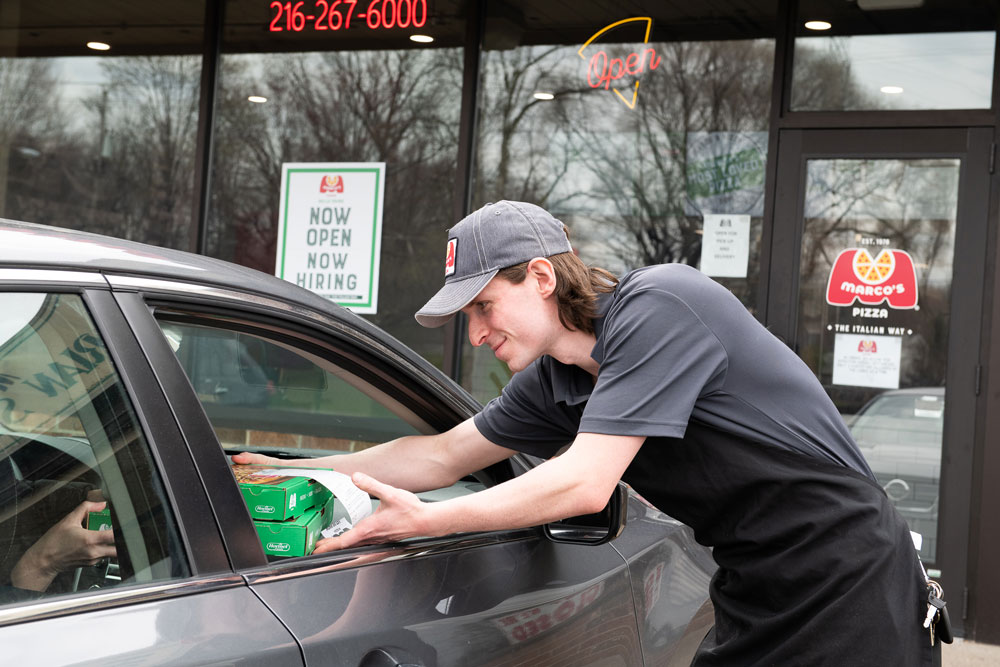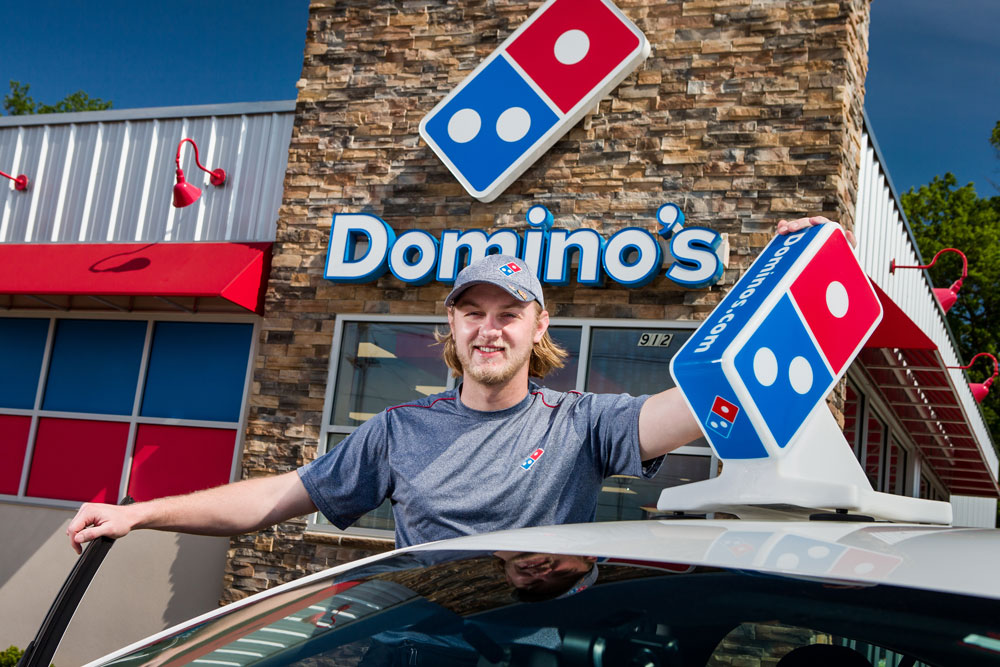- Major pizza chains plan to keep opening more and more stores—probably in your market, maybe right down the street from you.
- But independent pizzeria operators have hidden superpowers that the big chains lack. You just have to discover them and, of course, use them for good.
Related: Guest-centered strategy is key to survival for independent pizzerias
By Rick Hynum
The big pizza chains keep getting bigger. Success begets success, money makes money, and even a two-year pandemic can’t change that. While Americans were masking up and lying low at home in 2020, Papa Johns logged year-over-year domestic sales growth of 19%. For Marco’s Pizza, it was 24.7%, while Romeo’s Pizza’s sales growth blew up to 26.5%. “Scale matters in this industry,” said Sara Senatore, a senior restaurants analyst for Bank of America, in a January interview with Yahoo Finance Live. “And when you have a difficult operating environment [like a pandemic], scale matters even more.”
The large chains have huge negotiating power with suppliers. Their parent companies spend hundreds of millions on branding, advertising and marketing every year. Their technology teams have nailed online ordering and delivery down to a science. “So it has always been the case that the independent is at something of a disadvantage [compared] to the large chain,” Senatore added. “But never more so, I don’t think, than now.”
Fortunately, independent pizzeria operators have their own hidden superpowers that the big chains lack. Like any “secret origin” story, you just have to discover them and, of course, use them for good. But first let’s take a closer look at why now is the time to flex your muscles and fly to your own rescue.
“Get your story down so you can scream it from the rooftops. Why do you exist, what are your passions, and how do you and your team value your customers?”
— Bruce Hershey, Piper’s Scratch Pizza Shop
The Power of Chains
Yes, there are still more independent pizza shops (39,808) than chain locations (35,309) in the U.S. Even so, pizza chains logged $27.6 billion in sales last year, compared to $17.9 billion for independents. Meanwhile, they plan to keep opening more and more stores—probably in your market, maybe right down the street from you.
Papa John’s inked its largest-ever franchisee development deal last October. California Pizza Kitchen kicked off its first national franchise program in December. Fast-casual leader Blaze Pizza aims to open franchised stores in all 50 states. And Hungry Howie’s recently announced a new franchise incentive program offering up to $150,00 in free royalties for new multiunit operators. “This is the first time in the brand’s history that we have introduced a program this aggressive,” says Steve Clough, Hungry Howie’s director of franchise development.
Little Caesars isn’t exactly resting on its laurels, either. In November, Craig Sherwood, the chain’s vice president of U.S. development, told QSR magazine the time was “really, really ripe” for expansion. Little Caesars wants to open 50 new stores around New England, 35 in St. Louis, 15 in Denver, 25 in Charlotte, North Carolina, up to 10 in New Orleans, 30 in Tampa Bay, at least 12 in New York, and more than 50 in the Pacific Northwest.

Bruce Hershey, co-founder of Piper’s Scratch Pizza Shop
Then there’s Domino’s “fortressing” strategy—building out more and more stores, including in areas with existing locations. That approach shrinks delivery radius and makes it easier to get pizzas to customers quickly and less expensively. Domino’s CFO Stu Levy has said being the country’s No. 1 pizza chain isn’t good enough. Domino’s wants to be “a dominant No. 1.” Levy’s goal: Expand Domino’s presence from 6,355 stores to a whopping 8,000.
Most of these companies are household names. Fortunately, your pizzeria doesn’t have to be famous to compete with the chains. You just need to show customers that you’re different from and better than them.
“For me, the key is not to follow but to lead, so you don’t get caught up in the game of chase,” says Bruce Hershey, co-founder and chief marketing officer at Piper’s Scratch Pizza Shop in Palm Harbor, Florida. “Yes, I mean chase. So many small businesses make the sometimes-fatal mistake of trying to chase or emulate the big boys and girls. They forget that the larger chains have more at their disposal—namely, money and resources. But these same operators often fail to capitalize on where they can differentiate themselves from the larger chains—i.e., product and customer service. My company is living proof of what can be accomplished by focusing on these two aspects and by truly personalizing customer experience and building a sense of community.”
“Instead of useless ‘We’re hiring servers and cooks’ job posts, I drafted a career narrative that explains the culture and invites candidates in to taste the menu and be treated like a customer.”
— Baron Hanson, Pusateri’s Pizza

Pusateri’s Pizza hires team members with skills that go beyond serving and making pizza.
The Power of Storytelling
There’s a good story behind your pizzeria. And everyone loves a good story. So don’t underestimate storytelling as your marketing superpower. It’s one of your best advantages over corporate chains. “Get your story down so you can scream it from the rooftops,” Hershey says. “Why do you exist, what are your passions, and how do you and your team value your customers? Yes, we are in the pizza business, but we are really in the customer service business, right? So let’s serve them up a story they will love.”
How long has your restaurant been embedded in your community? Did your parents or grandparents open it? What were they like? Did your dad play football for the hometown team? Was your mom president of the debate club? These little details give your restaurant a history, a personality and an authenticity that a new chain store often lacks.
You’ve got present-day stories to tell as well. And your website and social media give you the chance to tell them through the written word, photos and videos. What’s the latest on your cute new baby? How do you make that chicken Parm pizza everybody loves? What makes your servers tick? How are you giving back to the community?
“A photo with the story of the local baseball team or other group that you support through your donations lets guests know you care about the community,” says Izzy Kharasch, a restaurant consultant and president of Hospitality Works in Deerfield, Illinois. “Share an action photo with the story of the employee who has been with you the longest. Post a short video of you preparing the pizza special of the week and tell us how you came up with it or if it’s an old family recipe. Dedicate a week to first responders, nurses, doctors, veterans, etc. Offer them something truly special. When they come in, take a picture, post it, and thank them for all they do and for being a guest.”
Consultant Matt Plapp, CEO of America’s Best Restaurants in Florence, Kentucky, agrees. “The best way to tell stories is through video,” he says. “Bring in the local high school coach whose girls basketball team went to the state championship for a live Facebook video to talk about the season and the team.”
Few, if any, of the major chains have a story to tell beyond this week’s coupon offer. Your story is one of a kind. So tell it every day on social media, and watch the likes and shares multiply.
Related: Why these pizza chains work with third-party delivery platforms

Marco’s Pizza expects to reach $1 billion in systemwide sales this year.
The Power of Smart Hiring
Your pizzeria is not a soulless corporation. You have real relationships with your employees. You care about them, and that’s another superpower. Take more time to find the right employees, pay a wage they can live on, and let them use and polish other skills besides running food to tables. In Stuart, Florida, Pusateri’s Pizza, specializing in Chicago thin-crust pies, offers opportunities for multiskilled staffers, according to Baron Hanson, a turnaround management consultant who advises Tom Bean, Pusateri’s owner.
“Instead of useless ‘We’re hiring servers and cooks: Apply today’ job posts, I drafted a career narrative that explains the culture and invites candidates in to taste the menu and to be treated like a customer instead of [a job seeker],” Hanson says. “We ask about their other skills, career goals or technological talents beyond spinning and serving pizzas. The looks on their faces as they gladly take the job and come on board are priceless. Do the big chains offer such independent and entrepreneurial opportunities? Of course not!”
Hanson points to a Pusateri’s employee named Dylan, a former DoorDash driver. Beyond an hourly wage and tips, Pusateri’s pays Dylan to work his magic on the website, app, social media, SEO and more. “These are advanced skills that would cost a fortune from a sexy, high-priced, outsourced digital marketing firm,” Hanson notes.
Pusateri’s tells its employees stories, too, Hanson says. “Over the airways and in print, Pusateri’s mentions employees by name, which has them literally jumping for joy. That’s something no national chain or franchise HR model can even begin to consider.”
Related: How MOD Pizza became one of the country’s fastest-growing restaurant chains

Top chains like Domino’s focus on speed and convenience, so independents should set themselves apart by focusing on relationships with guests.
The Power of Data
Your POS system is your super-strength. Using it correctly will raise your customer-service game and profitability so you can withstand competition from the chains. “From top-line summaries to granular daily stats, a smart POS system will help keep track of all insights a restaurant needs to run smoothly,” says Katie Swett, product lead for Square Online in San Francisco. “Pizzerias can see sales by category, item or payment type. These reports determine which items are best-sellers and those that are ordered least so your inventory ordering matches exactly what you need. Sales reports can identify busy and slow times of the day so restaurants can properly staff for each shift and provide customers with optimal service.”
Your POS system also lets you create a profile for every person who places an order—and that’s pure gold, Kharasch says. “Pizza operations have an incredible opportunity to capture customer data. The right POS will capture key information and, when the customer calls for their next order, their last order is on the screen. We have their phone number, email and any other key information if we ask the right questions.”
“The simplest way to collect data is with a form on your site to collect the info you want and need, such as first and last name, birthday—we all like to be wished a happy birthday—email address so you can share updates, and phone number,” Hershey says. Then, you need to “create and share real, raw content that showcases the brand’s personality. I don’t care how big a brand is—customers want to see its personality, its human side.”
You say you already have a POS system? Talk to your POS provider in depth and make sure you understand its full capabilities, then put it to work!
Related: Using your POS system to navigate the labor shortage
The Power of Loyalty
The chains have to lure customers with coupon offers. Guest loyalty is your superpower. “With roughly 30% of all restaurants offering a loyalty program and 69% of consumers claiming that where they can earn rewards influences their choice of a restaurant, it’s clear that a loyalty program is [important],” says Sam Neville of Mkonnekt in Irving, Texas, which offers marketing and technology solutions for restaurants.
“A loyalty program can be used to create exclusive offers for your valued customers,” Neville says. “Exclusive offers generate social currency, which customers are inclined to share, creating word-of-mouth in the process. Restaurants can experiment to create a wide range of exclusive offers, such as the ability to make reservations for events before the general public, or an invitation to try out a new entrée before it’s added to the menu.”
Piper’s Scratch Pizza Shop launched a loyalty program five months after opening for business, Hershey says. Its first campaign “explained the entire loyalty program benefits via email, social and in-store,” Hershey says. “One of the major reasons this was successful was due to [the program] being integrated with our POS partner, so customers can sign up at checkout in-store or via online ordering. We also enabled an email drip campaign that alerts customers when they earn points and reminders to use points. This has led to an increase of one to two more visits per month, which is priceless. We now have over 2,500 emails due to our loyalty program. Our customers love it because they get the surprise and delight of rewards when checking out.”
Related: How to build a successful rewards program
The Power of Relationships
Once you’ve created your loyalty program, stay in touch with customers via SMS (text) and email messages, Neville advises. “SMS is the most popular communication channel among all marketing strategies. It’s inexpensive, with a 97% delivery rate within four minutes. SMS messages have a 30% response rate on average and entice customers to act quickly.”
Just try not to go overboard. “This is a real balancing act,” Kharasch says. “With too many emails and too many texts, the guest will begin to ignore both. Be strategic, and do one of each one day per week. Choose the right day and send a simple message that is clear, concise and will get the guest to consider coming in or ordering delivery.”
Don’t waste your messages on promoting events—like the Super Bowl or Halloween—that already keep you busy anyway, Plapp says. Or if you do, offer something no one else—including the chains—would think about. “Look at the Super Bowl a few months ago,” Plapp said. “Every restaurant emailed about buying pizza from them on that day. We did not do that. Our clients, a few hundred restaurants, instead emailed and texted their database saying, ‘Click below and go to Facebook to guess the winner of the Big Game: Cincinnati or L.A.? You’ll be registered to win a $25 gift card.’ We not only saw 40% to 50% open rates and 10%-plus click-throughs, but clients reported record sales without even asking for business. Plus, their Facebook posts saw between 200 to 1,0000 comments.”
Related: Text your way to pizza marketing success
Niko Frangos, president of the six-store Rascal House company in Cleveland, sees every email and text as a branding opportunity. But, no matter what, he points out, “the customer relationship has to start or end with a human connection. The relationship can’t be all digital.”
And since the big chains focus increasingly on digital ordering, here’s another chance to flex your superpower. The pizza business is still a people business, and you know people. “When you’re serving someone, there has to be a touchpoint somewhere,” Frangos says. “It can be at the beginning, and digital things like email and text marketing can enhance the relationship, or it can be at the end, and email and text marketing can bring the customer to that point. Either way, a human connection is necessary for building a relationship with a customer.”
Frangos adds, “It all boils down to being honest with your marketing and messaging. That’s the starting point. If you are honest with who you are, your values, what you do, and don’t try to be something you’re really not, that’s priority No. 1. Be honest and smart about who you are.”
Rick Hynum is PMQ’s editor in chief.













